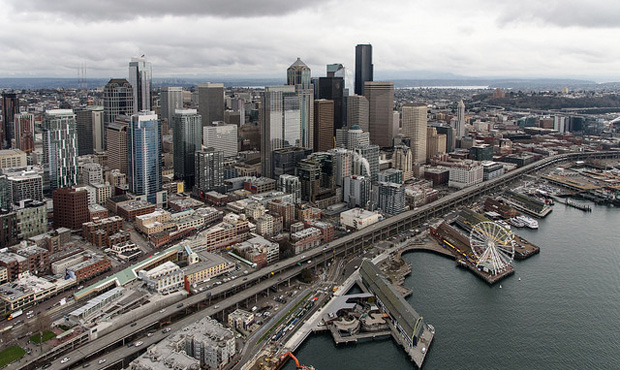I-5 lid a great idea, but a nightmare to implement
Dec 19, 2018, 6:11 PM

A proposed lid over I-5. (Lid I-5 courtesy photo)
(Lid I-5 courtesy photo)
Efforts to lid I-5 have been talked about for years now, as advocates have pushed for it as a way to reconnect the city of Seattle. But even if you agree with the reasoning, Seattle’s construction fatigue could be the biggest barrier it faces in implementation.
RELATED: What an I-5 lid might look like through downtown Seattle
“Lidding (I-5) would be a fabulous improvement on the city, but wow, if you’ve been in Seattle one year, the construction fatigue that I think all of us are feeling at this point is profound,” KIRO Radio’s Mike Lewis told Gee Scott, filling in on the Ron and Don Show.
Construction has been a fundamental part of Seattle for years now, holding the dubious honor of being the home to the most cranes in the country with 65 (second place is Chicago, with 40).
“It’s just project, after project, after project — it’s crazy,” noted Gee.
As Seattle grows, so do its many construction projects, including the upcoming removal of the Alaskan Way Viaduct, and the opening of the new SR 99 tunnel. Combined with the city’s consistent presence on “most congested cities” lists, that all makes for a populace that would love to take a break from jackhammers and closures.
“I think that there is a point at which you have to say ‘enough,'” said Lewis. “At least just a break for a little while, so it doesn’t feel like it’s everywhere you turn, you’re thwarted going from ‘A’ to ‘B.'”
So what exactly would lidding I-5 entail?
The goal of the project would be to cover a portion of I-5 that stretches between Denny Way and Madison Street in downtown Seattle, all in an effort to create land for public space and affordable housing, reports The Urbanist.
It’s an issue of space. With limited land and accelerated growth, an advocacy group for the project is seeking new and creative ways to make more efficient use of space, while potentially reducing noise and air pollution.
Proponents imagine a space with parks, housing, community centers, and streets, though one wonders if that street might get it’s own lid one day.
“I actually love the idea of capping I-5,” admitted Lewis. “It’s a great way to reclaim space that we lost when they dug the giant furrow directly through the heart of Seattle to build I-5 in the first place.”
When I-5 was originally built, entire neighborhoods were removed between downtown and Capitol Hill, an occurrence not at all uncommon in our region.
“This has been a problem all over the west — you had areas literally defined rich [or] poor based on where they put the freeway,” said Lewis.
In a city that seems to be approaching its limit in terms of its tolerance for traffic and construction delays, Lewis does see a potential compromise.
What I would like to see is a pilot project, maybe between two of the narrow bridges. Cap one section of it, see how it turns out, build a small park, [and] if it worked out and if they could do it without stopping traffic, alright, let’s try that — maybe like tiles, set it up as they go through, but not try to do the whole thing at once.
For now, the project is still very much in the “can this actually work?” stages, with a feasibility study set to be conducted in 2019. Funding for that study will be provided by a $1.5 million public benefit payment from the Washington State Convention Center, and will take a closer look at lid design, planning, permitting, and capital funding.


















